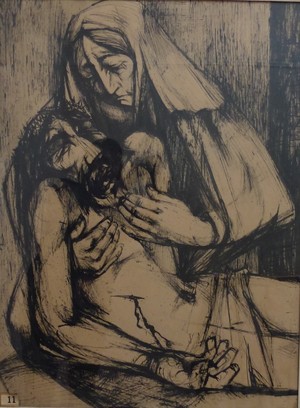'The Crucifixion', 'The Pieta', 'The Judas Kiss', by Gavin Alston c. 1961-2
Religious work by Gavin Alston, mostly pen and ink or gouache and ink.










Towards the end of his short life, Gavin Alston appears to have gravitated towards religious themes in his work. According to my mother, Gavin always said that in order to get a commission in Glasgow ‘you either had to be in the lodge or the church’. However, his dramatic, graphic and ‘expressionistic’ work reveals more than a purely superficial retelling of the Christian story.
Perhaps his interest in religious imagery was as a result of his friendship with his former tutor, Head of Mural Design, Walter Pritchard, a converted catholic, and Pritchard’s wife Sadie McLellan, lauded Scottish stained glass artist. He also worked for a time at the catholic schools, St. Aloysius (with friend, Tony Armstrong) and at St. Joseph’s, in Glasgow. But, aside from these obvious influences and parallels, there is something that cannot be ignored – Gavin’s work was deeply personal and reflective of his state of mind.
As an artist you cannot help but betray your inner thoughts/demons, something of your personal beliefs, your soul. If you cannot be honest about yourself then your work is empty. I believe every artwork of any worth has been a small (or big) battleground, where an artist has wrestled with abstract pictorial elements to convey their vision in representational or non-representational terms, and through the process you have to lay your heart open. In his ‘Power of Art’ series Simon Schama made it clear that understanding the personality, or the psychology of the artist , was an important factor in gaining a deeper understanding of the resultant work of art.
The bible has undoubtedly proved to be one of the greatest sources of visual imagery in the west. To take the most famous images from the Bible and reinterpret them would seem to me to be one of the most difficult things to do as an artist. How can you say anything new, add to what has already been said? Gavin did not shrink from the task, he tried to imbue his figures with feeling, raw emotion and he definitely wrestled with the well-known biblical imagery to retell it in a stark and expressionistic manner.
A selection of writing from contemporary articles
‘Royal Scottish Academy Summer Exhibition – 1962’ – The Scotsman -
Sir Sydney Goodsir Smith’
‘Descending into the bowels of the earth into room IX, you will come across two very interesting paintings by Gavin Alston of mysterious and fearsome masked figures (628, 635) from the world of Robert Leishman and Edward Burra or maybe some rococo German hell. Powerful and richly hued. You should notice also his dramatic and painful ink drawing, ‘Crucifixion’, in the next room.’
‘Exhibition of Painting at The Grail Gallery’ from the 'Evening News', May 24th 1963
‘With drawings and prints by Gavin Alston, the new and minute Grail Gallery, in George Street, Edinburgh shows it’s best exhibition to date. Alston (writes F.M.O. McCullogh) is a draughtsman of considerable, if erratic power, who is yet to subordinate an over-enthusiasm for characterization to the dictates of pictorial unity.
The graphic mask-like distortions of the head of Christ in the large drawings of ‘The Betrayal’ or ‘The Pieta’ and ‘a painting of the ‘The Crucifixion’ generate an atmosphere which is as disturbing as it is valid: the same works possess passages of carefully observed and tautly, sometimes delicately, rendered form. Unfortunately these disparate elements rarely coalesce into wholly effective translations of Alston’s tormented vision. But given time they will do.’
‘Painter takes Frank look at Religion’ by Emilio Coia from the 'Evening Dispatch', 25th May
‘An artist who says what he has to say with disarming candour and, one feels, from deep conviction is the Glasgow artist Gavin Alston who exhibits recent work at the Grail Book and Art centre, 36 George Street, Ediburgh.
Essentially a draughtsman in that the linear is always emphasized and forms organized rather in the manner of Roualt, Mr Alston aptly suits his talents to religious themes.
Paintings, drawings and monotypes are devoted to ‘The Crucifixion’, ‘The Plagues of Egypt’, detailed aspects of ‘The Last Supper’, and ‘The Seven Deadly Sins’- a series inspired by Spenser’s ‘The Faery Queen’.
The artistic quality of all these uncompromisingly personal expressions varies considerably, for Mr Alston either hits the nail on the head or misses by a mile.
When he succeeds within his pictorial limits one respects highly his emotive power.
His big painting of ‘The Crucifixion’, for example, is an admirable interpretation and a better piece of art than some famous, more contrived, evaluations by certain celebrated contemporary artists.’
Document Actions